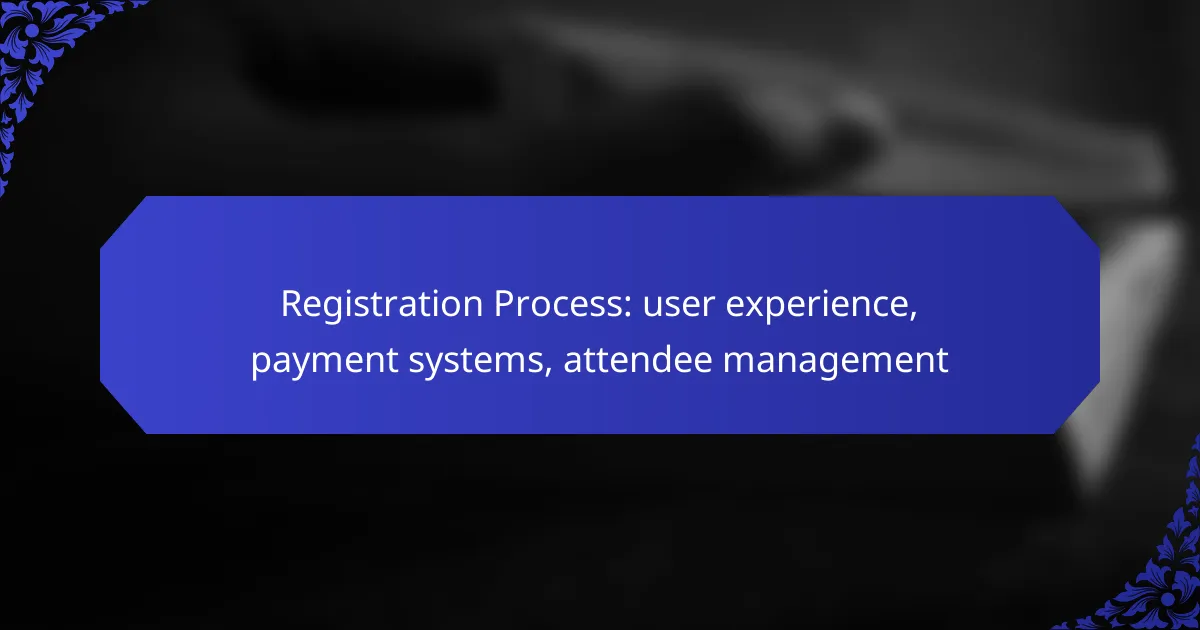The registration process is crucial for ensuring a seamless user experience, particularly in the UK, where user-friendly online forms and mobile compatibility are essential. By incorporating convenient and secure payment systems, such as PayPal and mobile payment options, organizers can cater to diverse attendee preferences. Furthermore, effective attendee management through streamlined communication and automation enhances overall satisfaction and engagement.

How to optimize the registration process in the UK?
To optimize the registration process in the UK, focus on creating user-friendly online forms, ensuring mobile compatibility, and providing real-time support. These elements enhance user experience, reduce drop-off rates, and streamline attendee management.
Streamlined online forms
Streamlined online forms are essential for a smooth registration process. Keep forms concise, asking only for necessary information such as name, email, and payment details. Use dropdowns and checkboxes to minimize typing and speed up completion.
Consider implementing auto-fill features and progress indicators to guide users through the registration steps. This can significantly reduce the time spent on forms, making the experience more efficient.
Mobile-friendly interfaces
A mobile-friendly interface is crucial as many users register via smartphones. Ensure your registration site is responsive, meaning it adjusts seamlessly to different screen sizes. This enhances usability and accessibility for all attendees.
Test the registration process on various devices to identify and fix any issues. Aim for a loading time of under three seconds to prevent users from abandoning the process due to frustration.
Real-time support options
Providing real-time support options can greatly improve user satisfaction during registration. Consider integrating live chat features or a dedicated help hotline to assist users with any questions or issues they encounter.
Additionally, having a comprehensive FAQ section can preemptively address common concerns, reducing the need for direct support. Ensure that support is available during peak registration times to handle increased inquiries effectively.

What payment systems are preferred by UK attendees?
UK attendees often favor payment systems that offer convenience, security, and familiarity. Popular options include PayPal, credit cards, and mobile payment solutions like Apple Pay and Google Pay, which cater to diverse preferences and enhance the overall registration experience.
PayPal integration
PayPal is a widely accepted payment system in the UK, known for its ease of use and strong buyer protection policies. Integrating PayPal into the registration process allows attendees to complete transactions quickly without needing to enter their card details each time.
When implementing PayPal, ensure that the integration is seamless and that users can easily navigate to the payment page. Offering PayPal as a payment option can increase conversion rates, as many users prefer it for its security features.
Credit card processing
Credit card processing remains a staple for UK attendees, with Visa and Mastercard being the most common choices. To facilitate smooth transactions, ensure that your payment gateway supports various credit card types and complies with PCI DSS standards for security.
Consider offering options for both one-time payments and recurring billing if applicable. Providing clear information about accepted cards and any potential fees can help manage attendee expectations and reduce cart abandonment.
Apple Pay and Google Pay support
Apple Pay and Google Pay are increasingly popular among UK attendees, especially for mobile users. These digital wallets allow for quick and secure transactions, making them ideal for on-the-go registrations.
To support these payment methods, ensure your payment processor is compatible and that your website is optimized for mobile devices. Highlighting these options can enhance user experience and attract tech-savvy attendees who prefer contactless payments.

How to manage attendees effectively?
Managing attendees effectively involves streamlining communication, tracking registrations, and ensuring smooth on-site experiences. Utilizing technology and automation can significantly enhance the attendee management process.
Automated confirmation emails
Automated confirmation emails are essential for keeping attendees informed about their registration status. These emails should include details such as event date, location, and any necessary instructions or materials. Sending these confirmations immediately after registration helps to reassure attendees and reduces inquiries.
To optimize the effectiveness of confirmation emails, consider personalizing them with the attendee’s name and event-specific information. This small touch can enhance engagement and make attendees feel valued.
Event management software
Event management software simplifies the process of tracking registrations, payments, and attendee information. These platforms often include features like ticketing, reporting, and communication tools, allowing for a centralized management approach. Popular options include platforms like Eventbrite, Cvent, and Whova.
When selecting software, evaluate your specific needs, such as budget, scalability, and user-friendliness. Many platforms offer tiered pricing based on features, so choose one that aligns with your event size and complexity.
On-site check-in solutions
On-site check-in solutions streamline the attendee arrival process, reducing wait times and enhancing the overall experience. Options include mobile check-in apps, QR code scanning, and self-service kiosks. These technologies can help manage large crowds efficiently.
Consider implementing a system that allows for real-time updates on attendee arrivals and capacity. This can help you adjust staffing levels and resources as needed, ensuring a smooth check-in experience for all attendees.

What are the key criteria for selecting registration software?
When selecting registration software, focus on user interface design, integration capabilities, and customer support availability. These criteria ensure a smooth user experience, seamless connections with other systems, and reliable assistance when needed.
User interface design
A user-friendly interface is crucial for both event organizers and attendees. Look for software that offers intuitive navigation, clear labeling, and mobile responsiveness to accommodate users on various devices.
Consider platforms that provide customizable templates to match your event branding. A visually appealing design can enhance the registration experience, encouraging more attendees to complete their registrations.
Integration capabilities
Effective registration software should integrate easily with other tools, such as payment processors, CRM systems, and marketing platforms. This connectivity streamlines data management and enhances overall efficiency.
Check for compatibility with popular services like PayPal, Stripe, or local payment gateways relevant to your region. A robust API can also facilitate custom integrations, allowing you to tailor the software to your specific needs.
Customer support availability
Reliable customer support is essential for resolving issues quickly. Look for software that offers multiple support channels, such as live chat, email, and phone assistance, preferably with 24/7 availability.
Evaluate the responsiveness and expertise of the support team through reviews and testimonials. A strong support system can significantly reduce downtime and improve the overall user experience during the registration process.

How to enhance user experience during registration?
Enhancing user experience during registration involves streamlining the process, ensuring clarity, and providing personalized options. Focusing on these elements can significantly reduce drop-off rates and improve overall satisfaction.
Personalized registration paths
Creating personalized registration paths allows users to navigate the process based on their specific needs and preferences. For instance, offering tailored options for different attendee types—such as speakers, sponsors, or general attendees—can make the experience more relevant and engaging.
Consider implementing conditional logic in your registration forms, which adjusts questions based on previous answers. This approach can minimize unnecessary steps and keep users focused on what matters to them.
Clear communication of event details
Clear communication of event details is crucial for a smooth registration experience. Ensure that all necessary information, such as event dates, locations, pricing, and agenda, is easily accessible and presented in a straightforward manner.
Utilize bullet points or tables to summarize key information, making it easy for attendees to grasp essential details at a glance. Regular updates via email or a dedicated event website can also keep participants informed and engaged.
Feedback collection mechanisms
Implementing feedback collection mechanisms during and after the registration process can provide valuable insights into user experience. Simple surveys or quick polls can help identify pain points and areas for improvement.
Consider using tools that allow for real-time feedback, such as chatbots or interactive forms. This immediate input can guide adjustments and enhance the registration experience for future events.

What are the emerging trends in registration processes?
Emerging trends in registration processes focus on enhancing user experience, ensuring secure transactions, and improving attendee management. Key developments include AI-driven personalization and the use of blockchain technology for secure payments.
AI-driven personalization
AI-driven personalization tailors the registration experience to individual preferences and behaviors. By analyzing user data, platforms can offer customized options, such as personalized event recommendations and targeted communications, which can significantly enhance attendee engagement.
To implement AI-driven personalization effectively, organizations should collect data on user interactions and preferences. This data can be used to create dynamic registration forms that adapt based on user input, improving completion rates and satisfaction.
Blockchain for secure transactions
Blockchain technology offers a secure and transparent method for processing registration payments. By utilizing decentralized ledgers, organizations can reduce the risk of fraud and ensure that transactions are tamper-proof, which is crucial for maintaining attendee trust.
When considering blockchain for registration, organizations should evaluate the costs and technical requirements of implementation. While it may involve initial investment, the long-term benefits include lower transaction fees and enhanced security, making it a worthwhile consideration for large-scale events.
